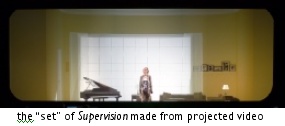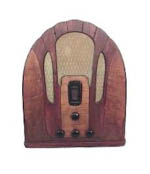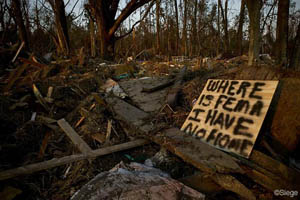People have been talking about internet television for a while now. But Google and Yahoo’s unveiling of their new video search and subscription services last week at the Consumer Electronics Show in Las Vegas seemed to make it real.
Sifting through the predictions and prophecies that subsequently poured forth, I stumbled on something sort of interesting — a small concrete discovery that helped put some of this in perspective. Over the weekend, Slate Magazine quietly announced its partnership with “meaningoflife.tv,” a web-based interview series hosted by Robert Wright, author of Nonzero and The Moral Animal, dealing with big questions at the perilous intersection of science and religion.

Launched last fall (presumably in response to the intelligent design fracas), meaningoflife.tv is a web page featuring a playlist of video interviews with an intriguing roster of “cosmic thinkers” — philosophers, scientists and religious types — on such topics as “Direction in evolution,” “Limits in science,” and “The Godhead.”
This is just one of several experiments in which Slate is fiddling with its text-to-media ratio. Today’s Pictures, a collaboration with Magnum Photos, presents a daily gallery of images and audio-photo essays, recalling both the heyday of long-form photojournalism and a possible future of hybrid documentary forms. One problem is that it’s not terribly easy to find these projects on Slate’s site. The Magnum page has an ad tucked discretely on the sidebar, but meaningoflife.tv seems to have disappeared from the front page after a brief splash this weekend. For a born-digital publication that has always thought of itself in terms of the web, Slate still suffers from a pretty appalling design, with its small headline area capping a more or less undifferentiated stream of headlines and teasers.
Still, I’m intrigued by these collaborations, especially in light of the forecast TV-net convergence. While internet TV seems to promise fragmentation, these projects provide a comforting dose of coherence — a strong editorial hand and a conscious effort to grapple with big ideas and issues, like the reassuringly nutritious programming of PBS or the BBC. It’s interesting to see text-based publications moving now into the realm of television. As Tivo, on demand, and now, the internet atomize TV beyond recognition, perhaps magazines and newspapers will fill part of the void left by channels.
Limited as it may now seem, traditional broadcast TV can provide us with valuable cultural touchstones, common frames of reference that help us speak a common language about our culture. That’s one thing I worry we’ll lose as the net blows broadcast media apart. Then again, even in the age of five gazillion cable channels, we still have our water-cooler shows, our mega-hits, our television “events.” And we’ll probably have them on the internet too, even when “by appointment” television is long gone. We’ll just have more choice regarding where, when and how we get at them. Perhaps the difference is that in an age of fragmentation, we view these touchstone programs with a mildly ironic awareness of their mainstream status, through the multiple lenses of our more idiosyncratic and infinitely gratified niche affiliations. They are islands of commonality in seas of specialization. And maybe that makes them all the more refreshing. Shows like “24,” “American Idol,” or a Ken Burns documentary, or major sporting events like the World Cup or the Olympics that draw us like prairie dogs out of our niches. Coming up for air from deep submersion in our self-tailored, optional worlds.
Category Archives: media
the year in ideas
In developed nations, and in the US in particular, high-speed wireless access to the Internet is a given for the affluent and an achievable possibility for most. In the rest of the world, owning a computer is a dream for a community, and a fantasy for the individual. At this moment, away in the central mountains of Colombia, I am virtually disconnected from the world, though quite connected to the splendor of nature. I’m writing this relying on uncertain electricity that, if it fails, will be backed up by a gas generator that will keep food fresh and beer cold, the hell with the laptop. Reading one of last week’s Medellín’s newspapers, I was surprised to see news of the advent of the BlueBerry as a technological advance that will reach the city in early 2006. Medellín is a booming, sophisticated Third World city of more than 3.5 million people. This piece of news made clearer for me, more than ever, how in the US we take technology for granted when, in fact, it is the domain of only a small minority of the world. This doesn’t mean that the rest don’t need connectivity, it means that if they are being pushed to play in the global monopoly game, they must have it. From that perspective, I bring the New York Times Magazine’s fifth edition of The Year in Ideas” (12/11/2005.) As always, it examines a number of trends and fads that, in a way or another, were markers of the year. Considering the year at the Institute and its pursuit of the meaningful among myriad innovations, I’ll review some of the ideas the Times chose, that meet the ones the Institute brought to the front throughout the year. Beyond the noteworthy technological inventions, it is the human contribution, the users’ innovative ways of dealing with what already exists in the Internet, which make them worth reflecting upon.
The political power of the blogosphere is an accepted fact, but it is the media infrastructure that passes on what is said on blogs what has given the conservatives the upper hand. Even though Howard Dean’s campaign epitomized the power of the liberal blogosphere, the so called “Net roots” continue to be regarded as the terrain of young people with the time in their hands to participate in virtual dialogue. The liberal’s approach blogs as a forum to air ideas and to criticize not only their opponents but also each other, differs greatly from that of the conservatives’. They are not particularly interested in introspection and use the Web to support their issues and to induce emotional responses from their base. But, it is their connection to a network of local and national talk-radio and TV shows what has given exposure and credibility to the conservative blogs. Here, we have a sad, but true, example of how it is the coalescence of different media what matters, not their insular existence.
The news media increasingly have been using the Web both as an enhancer and as a way to achieve two-way communications with the public. An exciting example of the meeting of journalism and the blog is the New Orleans Times-Picayune. Before Katrina hit the city, they set up a page on their Web site called “Hurricane Katrina Weblog.” Its original function was supplemental. However, when the flood came and the printed edition was shut down, the blog became the newspaper. Even though the paper’s staff kept compiling a daily edition as a download, the blog was brimming with posts appearing throughout the day and readership grew exponentially, getting 20 to 30 million page views per day. The paper continued posting carefully edited stories interspersed with short dispatches phoned or e-mailed to the newspaper’s new headquarters in Baton Rouge. In the words of Paul Tough, “what resulted was exciting and engrossing and new, a stream-of-consciousness hybrid that combined the immediacy and scattershot quality of a blog with the authority and on-the-scene journalism of a major daily newspaper.”
Joshua M. Marshall, editor of the blog Talkingpointsmemo.com, decided to ask his readers to share their knowledge of the ever spreading Washington scandals in an effort to keep abreast of news. He called his experiment “open-source investigative reporting.” Marshall’s blog has about 100,000 readers a day and he saw in them the potential to gather news in a nationwide basis. For instance, he relied on his readers’ expertise with Congressional ethics code in order to determine if Jack Abramoff’s gifts were violations. What Marshall has come up with is a very large news-gathering and fact-checking network, a healthy alternative to traditional journalism.
Podcasting has become another alternative to broadcasting which provides the ability to access audio and video programs as soon as they’re delivered to your computer, or to pile them up as you do with written media. Now, through iTunes, we are experiencing the advent of homemade video postcasts. Some of them have already thousands of viewers. Potentially, this could become the next step of community access television.
The mash-up of data from different web sites has gained thousands of adepts. One of the first ones was Adrian Holovaty’s Chicagocrime.org, a street map of Chicago from Google overlaid with crime statistics from the Chicago Police online database. Following this, many people started to make annotated maps, organizing all sorts of information geographically from real-estate listings to memory maps. The social possibilities of this personal cartography are enormous. The Times brings Matthew Haughey’s “My Childhood, Seen by Google Maps,” as an example of an elegant and evocative project. If we think of the illuminated maps that expanded the world and ignited the imagination of many explorers, this new form of cartography brings a similar human dimension to the perfect satellite maps.
Thomas Vander Wal has called “folksonomy” to tagging taken to the level of taxonomy. The labeling of people’s photos, on Flicker for instance, gets richer by the additions of others who tag the same photos for their own use. Daniel H. Pink claims, “The cumulative force of all the individual tags can produce a bottom-up, self organized system for classifying mountains of digital material.” In an interesting twist, several institutions that are part of the Art Museum Community Cataloging Project, including the San Francisco Museum of Modern Art and the Guggenheim, are taking a folksonomic approach to their online collections by allowing patrons to supplement the annotations done by curators, making them more accessible and useful to people.
The effort of Nicholas Negroponte, chairman of the MIT’s Media Lab, to raise the funds to have a group of his colleagues design a no-frills, durable, and cheap computer for the children of the world is a terrific one. Having laptops equipped with a hand crank, in absence of electricity, and using wireless peer-to-peer connections to create a local network will make it easier to access the Internet from economically challenged areas of the world, notwithstanding the difficulties this presents. The detractors of Negroponte’s effort claim that children in Africa, for instance, will not benefit from having access to the libraries of the world if they don’t understand foreign languages; that children with little exposure to modern civilization will suddenly have access to pornography and commercialism; and that wealthy donors should concentrate on malaria eradication before giving an e-mail address to every child. Negroponte, as Jeffrey Sachs, Bono, Kofi Annan, and many others, know that education along with connectivity, are key to bring the next generation out of the poverty cycle to which they have been condemned by foreign powers interested in the resources of their countries, and by every corrupt local regime that has worked along the lines of those powers. The $100 laptop, accompanied by a sound and humane program to use them will bring enormous benefits.
A. O. Scott’s review of the documentary as a genre that supplies satisfaction not from Hollywood formulas but from the real world, reminded me of Bob Stein’s quest for thrills beyond technologically enhanced reality. A factor of the postmodern condition is the unprecedented immediate accessibility to the application of scientific knowledge that technology brings, accessibility that has permeated our relationships with and towards everything. Knowledge has acquired an unsettling superficiality because it has become an economic product. Technology is used and abused, forced upon the consumer in all sorts of ways and Hollywood’s productions are the obvious example. 2005 was the year of the documentary, and I suspect this has to do with a yearning for the human, for the real, for the immediate, for the unmediated. A. O. Scott eloquently traces that line when he praises Luc Jacquet’s “March of the Penguins” as the documentary that hits it all; epic journey, humor, tenderness and suspense, as well as “an occasion for culture-war skirmishing. In short it provided everything you’d want from a night at the movies, without stars or special effects. It’s almost too good to be true.” With that I greet 2006.
curbside at the WTO
A little while ago I came across this website maintained by a group of journalism students, business writers and bloggers in Hong Kong providing “frontline coverage” of the current WTO meetings. The site provides a mix of on-the-ground reporting, photography, event schedules, and useful digests of global press coverage of the week-long event and surrounding protests. It feels sort of halfway between a citizen journalism site and a professional news outlet. It’s amazing how this sort of thing can be created practically overnight.
They have a number of good photo galleries. Here are the Korean farmers jumping into Hong Kong Harbor:

pulitzers will accept online journalism
Online news is now fair game for all fourteen journalism categories of the Pulitzer Prize (previously only the Public Service category accepted online entries). However, online portions of prize submissions must be text-based, and the only web-exclusive content accepted will be in the breaking news reporting and breaking news photography categories.  But this presumably opens the door to some Katrina-related Pulitzers this April. I would put my bets on nola.com, the New Orleans Times-Picayune site that kept reports flying online throughout the hurricane.
But this presumably opens the door to some Katrina-related Pulitzers this April. I would put my bets on nola.com, the New Orleans Times-Picayune site that kept reports flying online throughout the hurricane.
Of course, the significance of this is mainly symbolic. When the super-prestigious Pulitzer (that’s him to the right) starts to re-align its operations, you know there are bigger plate tectonics at work. This would seem to herald an eventual embrace of blogs, most obviously in the areas of commentary, beat reporting, community service, and explanatory reporting (though investigative reporting may not be far off). The committee would do well to consider adding a “news analysis” category for all the fantastic websites, many of them blogs, that help readers make sense of the news and act as a collective watchdog for the press.
Also, while the Pulitzer changes evince a clear preference for the written word, it seems inevitable that inter-media journalism will continue to gain in both quality and legitimacy. We’ll probably look back on all the Katrina coverage as the watershed moment. Newspapers (some of them anyway) will figure out that to stay relevant, and distinctive enough not to be pulled apart by aggregators like Google or Yahoo news search, they will have to weave a richer tapestry of traditional reporting, commentary, features, and rich multimedia: a unique window to the world.
Nola.com didn’t just provide good, constant coverage, it saved lives. It was an indispensible, unique portal that could not be matched by any aggregator (though harnessing the power of aggregation is part of what made it successful). The crisis of the hurricane put in relief what could be a more everyday strategy for newspapers. The NY Times currently is experimenting with this, developing a range of multimedia features and cordoning off premium content behind its Select pay wall. While I don’t think they’ve yet figured out the right combination of premium content to attract large numbers of paying web subscribers, their efforts shouldn’t necessarily be dismissed.
Discussions on the future of the news industry usually center around business models and the problem of solvency with a web-based model. These questions are by no means trivial, but what they tend to leave out is how the evolving forms of journalism might affect what readers consider valuable. And value is, after all, what you can charge for. It’s fatalistic to assume that the web’s entropic power will just continue to wear down news institutions until they vanish. The tendency on the web toward fragmentation is indeed strong, but I wouldn’t underestimate the attraction of a quality product.
A couple of years ago, file sharing seemed to spell doom for the music industry, but today online music retailers are outselling most physical stores. Perhaps there is a way for news as well, but the news will have to change. Dan Gillmor is someone who has understood this for quite some time, and I quote from a rather prescient opinion piece he wrote back in 1997 when the Pulitzers were just beginning to wonder what to do about all this new media (this came up today on the Poynter Online-News list):
When we take journalism into the digital realm, media distinctions lose their meaning. My newspaper is creating multimedia journalism, including video reports, for our Web site. We strongly believe that the online component of our work augments what we sometimes call the “dead-tree” edition, the newspaper itself. Meanwhile, CNN is running text articles on its Web site, adding context to video reports.
So you have to ask a simple question or two: Online, what’s a newspaper? What’s a broadcaster?
Suppose CNN posts a particularly fine video report on its Web site, augmented by old-fashioned text and graphics. If the Pulitzer Prizes are o pen to online content, the CNN report should be just as valid an entry as, say, a newspaper series posted online and augmented with video.
And what about the occasionally exceptional journalism we’re seeing from Web sites (or on CD-ROMs) produced by magazines, newsletters, online-only companies or even self-appointed gadflies? Corporate propaganda obviously will fail the Pulitzer test, but is a Microsoft-sponsored expose of venality by a competitor automatically invalid when it’s posted on the Microsoft Network news site or MSNBC? Drawing these lines will take serious wisdom, unless the Pulitzer people decide simply to ignore trends and keep the prizes the way they are, in which case the awards will become quaint – or worse, irrelevant.
I’m also intrigued by another change made by the Pulitzer committee (from the A.P.):
In a separate change, the upcoming Pulitzer guidelines for the feature writing category will give ”prime consideration to quality of writing, originality and concision.” The previous guidelines gave ”prime consideration to high literary quality and originality.”
Drop the “literary” and add “concision.” A move to brevity and a more colloquial character are already greatly in evidence in the blogosphere and it’s beginning to feed back into the establishment press. Employing once again the trusty old Pulitzer as barometer, this suggests that that most basic of journalistic forms — “the story” — is changing.
are we real or are we memorex
i saw four live performances and a dozen gallery shows over the past few days; one theme kept coming up– what is the relationship of simulated reality to reality. here are some highlights and weekend musings.
thursday night: “Supervision,” a play by the Builders Association and DBox about  the infosphere which seems to know more about us than we do — among other things “it” never forgets and rarely plays mash-up with our memories the way human brains are wont to do. the play didn’t shed much light on what we could or should do about the encroaching infosphere but there was one amazing moment when video started shooting from left to right across the blank wall behind the actors. within moments a complete set was “constructed” out of video projections — so seamlessy joined at the edges and so perfectly shot for the purpse that you quickly forgot you were looking at video.
the infosphere which seems to know more about us than we do — among other things “it” never forgets and rarely plays mash-up with our memories the way human brains are wont to do. the play didn’t shed much light on what we could or should do about the encroaching infosphere but there was one amazing moment when video started shooting from left to right across the blank wall behind the actors. within moments a complete set was “constructed” out of video projections — so seamlessy joined at the edges and so perfectly shot for the purpse that you quickly forgot you were looking at video.
friday night: Nu Voices six guys making amazing house music, including digitized-sounding vocals, entirely with their voices. one of the group, Masai Electro, eerily imitated the sounds laurie anderson makes with her vocoder or that DJs make when they process vocals to sound robotic. the crowd loved it which made me wonder why we are so excited about hearing a human pretend to be a machine? i asked masai electro why he thinks the audience likes what he does so much. he had never been asked the question before and evidently hadn’t thought about it, but then spontaneously answered “because that’s where we’re going” meaning that humans are becoming machines or at least are becoming “at one” with them.
saturday afternoon: Clifford Ross’ very large landscapes (13′ x 6′) made with a super high resolution surveillance camera. a modern attempt at hudson river school lush landscapes. because of the their size and detail, you feel as if you are looking out a window at reality; makes you long for the “natural world” most of us rarely encounter.

left with a bunch of questions
does it make a difference if our experience is “real” or “simulated.” does that way of looking at things even make sense anymore. when we manage to add the smell of fresh air, the sound of the wind, the rustle of the grass, the bird in flight and the ability to walk around in life-size 3-D spaces to the clifford ross photos, what will be the meaningful difference between walking in the countryside and opening the latest “you are there” coffee table book of the future. in a world with limited resources i can see the value of subsituting vicarious travel for the real thing (after all if all 7 billion of us traipsed out to the galapagos during our lifetimes, the “original” would be overrun and despoiled, turning it into its opposite). but what does it mean if almost all of our experience is technologically simulated and/or mediated?
Pedro Meyer in his comment about digitally altered photos says that all images are subjective which makes altered/not-altered a moot distinction. up until now the boundary between mediated objects and “reality” was pretty obvious, but i wonder if that changes when the scale is life-like and 3D. the Ross photos and the DBox video projections foreshadow life-size media which involves all the senses. the book of the future may not be something we hold in our hands, it might be something a 3-dimensional space we can inhabit. does it make any difference if i’m interacting only with simulacra?
flushing the net down the tubes
Grand theories about upheavals on the internet horizon are in ready supply. Singularities are near. Explosions can be expected in the next six to eight months. Or the whole thing might just get “flushed” down the tubes. This last scenario is described at length in a recent essay in Linux Journal by Doc Searls, which predicts the imminent hijacking of the net by phone and cable companies who will turn it into a top-down, one-way broadcast medium. In other words, the net’s utopian moment, the “read/write” web, may be about to end. Reading Searls’ piece, I couldn’t help thinking about the story of radio and a wonderful essay Brecht wrote on the subject in 1932:

Here is a positive suggestion: change this apparatus over from distribution to communication. The radio would be the finest possible communication apparatus in public life, a vast network of pipes. That is to say, it would be if it knew how to receive as well as to transmit, how to let the listener speak as well as hear, how to bring him into a relationship instead of isolating him. On this principle the radio should step out of the supply business and organize its listeners as suppliers….turning the audience not only into pupils but into teachers.
Unless you’re the military, law enforcement, or a short-wave hobbyist, two-way radio never happened. On the mainstream commercial front, radio has always been about broadcast: a one-way funnel. The big FM tower to the many receivers, “prettifying public life,” as Brecht puts it. Radio as an agitation? As an invitation to a debate, rousing families from the dinner table into a critical encounter with their world? Well, that would have been neat.
Now there’s the internet, a two-way, every-which-way medium — a stage of stages — that would have positively staggered a provocateur like Brecht. But although the net may be a virtual place, it’s built on some pretty actual stuff. Copper wire, fiber optic cable, trunks, routers, packets — “the vast network of pipes.” The pipes are owned by the phone and cable companies — the broadband providers — and these guys expect a big return (far bigger than they’re getting now) on the billions they’ve invested in laying down the plumbing. Searls:
The choke points are in the pipes, the permission is coming from the lawmakers and regulators, and the choking will be done….The carriers are going to lobby for the laws and regulations they need, and they’re going to do the deals they need to do. The new system will be theirs, not ours….The new carrier-based Net will work in the same asymmetrical few-to-many, top-down pyramidal way made familiar by TV, radio, newspapers, books, magazines and other Industrial Age media now being sucked into Information Age pipes. Movement still will go from producers to consumers, just like it always did.
If Brecht were around today I’m sure he would have already written (or blogged) to this effect, no doubt reciting the sad fate of radio as a cautionary tale. Watch the pipes, he would say. If companies talk about “broad” as in “broadband,” make sure they’re talking about both ends of the pipe. The way broadband works today, the pipe running into your house dwarfs the one running out. That means more download and less upload, and it’s paving the way for a content delivery platform every bit as powerful as cable on an infinitely broader band. Data storage, domain hosting — anything you put up there — will be increasingly costly, though there will likely remain plenty of chat space and web mail provided for free, anything that allows consumers to fire their enthusiasm for commodities through the synapse chain.
 If the net goes the way of radio, that will be the difference (allow me to indulge in a little dystopia). Imagine a classic Philco cathedral radio but with a few little funnel-ended hoses extending from the side that connect you to other listeners. “Tune into this frequency!” “You gotta hear this!” You whisper recommendations through the tube. It’s sending a link. Viral marketing. Yes, the net will remain two-way to the extent that it helps fuel the market. Web browsers, like the old Philco, would essentially be receivers, enabling participation only to the extent that it encouraged others to receive.
If the net goes the way of radio, that will be the difference (allow me to indulge in a little dystopia). Imagine a classic Philco cathedral radio but with a few little funnel-ended hoses extending from the side that connect you to other listeners. “Tune into this frequency!” “You gotta hear this!” You whisper recommendations through the tube. It’s sending a link. Viral marketing. Yes, the net will remain two-way to the extent that it helps fuel the market. Web browsers, like the old Philco, would essentially be receivers, enabling participation only to the extent that it encouraged others to receive.
You might even get your blog hosted for free if you promote products — a sports shoe with gelatinous heels or a music video that allows you to undress the dancing girls with your mouse. Throw in some political rants in between to blow off some steam, no problem. That’s entrepreneurial consumerism. Make a living out of your appetites and your ability to make them infectious. Hip recommenders can build a cosy little livelihood out of their endorsements. But any non-consumer activity will be more like amateur short-wave radio: a mildly eccentric (and expensive) hobby (and they’ll even make a saccharine movie about a guy communing with his dead firefighter dad through a ghost blog).
Searls sees it as above all a war of language and metaphor. The phone and cable companies will dominate as long as the internet is understood fundamentally as a network of pipes, a kind of information transport system. This places the carriers at the top of the hierarchy — the highway authority setting the rules of the road and collecting the tolls. So far the carriers have managed, through various regulatory wrangling and court rulings, to ensure that the “transport metaphor” has prevailed.
But obviously the net is much more than the sum of its pipes. It’s a public square. It’s a community center. It’s a market. And it’s the biggest publishing system the world has ever known. Searls wants to promote “place metaphors” like these. Sure, unless you’re a lobbyist for Verizon or SBC, you probably already think of it this way. But in the end it’s the lobbyists that will make all the difference. Unless, that is, an enlightened citizens’ lobby begins making some noise. So a broad, broad as in broadband, public conversation should be in order. Far broader than what goes on in the usual progressive online feedback loops — the Linux and open source communities, the creative commies, and the techno-hip blogosphere, that I’m sure are already in agreement about this.
Google also seems to have an eye on the pipes, reportedly having bought thousands of miles of “dark fiber” — pipe that has been laid but is not yet in use. Some predict a nationwide “Googlenet.” But this can of worms is best saved for another post.
alternative journalisms
Craigslist founder Craig Newmark has announced he will launch a major citizen journalism site within the next three months. As quoted in The Guardian:
The American public has lost a lot of trust in conventional newspaper mechanisms. Mechanisms are now being developed online to correct that.
…It was King Henry II who said: ‘Won’t someone rid me of that turbulent priest?’ We have seen a modern manifestation of that in the US with the instances of plausible deniability, the latest example of that has been the Valerie Plame case and that has caused damage.
Can a Craiglist approach work for Washington politics? It’s hard to imagine a million worker ants distributed across the nation cracking Plamegate. You’re more likely to get results from good old investigative reporting, but combined with a canny postmodern sense of spin (and we’re not just talking about the Bush administration’s spin, but Judith Miller’s spin, The New York Times’ spin) and the ability to make that part of the story. Combine the best of professional journalism with the best of the independent blogosphere. Can this be done?
Josh Marshall of Talking Points Memo fame wants to bridge the gap with a new breed of “reporter-blogger,” currently looking to fill two such positions — paid positions — for a new muckraking blog that will provide “wall-to-wall coverage of corruption, self-dealing, and betrayals of the public trust in today’s Washington” (NY Sun has details). While other high-profile bloggers sign deals with big media, Marshall clings fast to his independence, but recognizes the limitations of not being on the ground, in the muck, as it were. He’s banking that his new cyborgs might be able to shake up the stagnant Washington press corps from the inside, or at least offer readers a less compromised view (though perhaps down the road fledgeling media empires like Marshall’s will become the new media establishment).
 That’s not to say that the Craigslist approach will not be interesting, and possibly important. It was dazzling to witness the grassroots information network that sprung up on the web during Hurricane Katrina, including on the Craigslist New Orleans site, which became a clearinghouse for news on missing persons and a housing directory for the displaced. For sprawling catastrophes like this it’s impossible to have enough people on the ground. Unless the people on the ground start reporting themselves.
That’s not to say that the Craigslist approach will not be interesting, and possibly important. It was dazzling to witness the grassroots information network that sprung up on the web during Hurricane Katrina, including on the Craigslist New Orleans site, which became a clearinghouse for news on missing persons and a housing directory for the displaced. For sprawling catastrophes like this it’s impossible to have enough people on the ground. Unless the people on the ground start reporting themselves.
Citizen journalists also pick up on small stories that slip through the cracks. You could say the guy who taped the Rodney King beating was a “citizen journalist.” You could say this video (taken surreptitiously on a cellphone) of a teacher in a New Jersey high school flipping out at a student for refusing to stand for the national anthem is “citizen journalism.” Some clips speak for themselves, but more often you need context, you need to know how to frame it. The interesting thing is how grassroots journalism can work with a different model for contextualization. The New Jersey video made the rounds on the web and soon became a story in the press. One person slaps up some footage and everyone else comments, re-blogs and links out. The story is told collectively.
beautiful? if so, why?
Sony Europe is promoting a new screen technology with a TV commercial featuring 250,000 brightly colored balls rolling down a San Francisco street. despite the maudlin soundtrack the sight of a quarter of a million balls floating chaotically down the hill is spectacular. this is partially because the piece is silly, fantastical, and brilliantly executed. i wonder though, if part of the reason people like the ad so much is because real balls are rolling on a real street — because the absence of any computer graphics is so unusual in our increasingly everything-so-neat-and-clean digital mediascape? this is not meant to be a rhetorical question. what do you think?

gawker blogs to appear on yahoo
Gawker Media, the Conde Nast of the blogosphere, has just sold distribution rights for five of its blogs to Yahoo. Selected posts from Gawker, Wonkette, Gizmodo, Lifehacker and Defamer will soon appear daily on the Yahoo news portal.
Not so worrisome (or surprising) to see blogs like these going corporate. From the beginning, they’ve sort of pitched themselves as commodities — the tabloids and gadget rags of the blogosphere. But when blogging comes fully front and center as the next hip business strategy — that authentic unfiltered element with which to adorn your comapany’s image (hang some humans on the doorpost) — then we may see a massive rush to rake up the brighter talents with lucrative little hosting deals. I’d hate to see bloggers foresake their independence like this. Then again, it might clear the way for a whole new generation of authentic voices.
malcom gladwell on the social life of paper.
I’m going to devote a series of posts to some (mostly online) texts that have been useful in my teaching and thinking about new media, textuality, and print technologies over the past few years. To start, I’d like to resurrect a three-year old New Yorker piece by Malcom Gladwell called “The Social Life Of Paper,” which distills the arguments of Abigail Sellen and Richard Harper’s book The Myth of the Paperless Office.
Gladwell (like Sellen and Harper) is interested in whether or not giving up paper entirely is practical or even possible. He suggests that for some tasks, paper remains the “killer app;” attempts to digitize such tasks might actually make them more difficult to do. His most compelling example, in the opening paragraph of his article, is the work of the air traffic controller:
On a busy day, a typical air-traffic controller might be in charge of as many as twenty-five airplanes at a time–some ascending, some descending, each at a different altitude and travelling at a different speed. He peers at a large, monochromatic radar console, tracking the movement of tiny tagged blips moving slowly across the screen. He talks to the sector where a plane is headed, and talks to the pilots passing through his sector, and talks to the other controllers about any new traffic on the horizon. And, as a controller juggles all those planes overhead, he scribbles notes on little pieces of paper, moving them around on his desk as he does. Air-traffic control depends on computers and radar. It also depends, heavily, on paper and ink.
Gladwell goes on to make the point that this while kind of reliance on bit of paper drives productivity-managers crazy, anyone who tries to change the way that an air traffic controller works is overlooking a simple fact: the strips of paper supply a stream of “cues” that mesh beautifully with the cognitive labor of the air traffic controller; they are, Gladwell says, “physical manifestations of what goes on inside his head.”
Expanding on this example, Gladwell goes on to argue that while computers are excellent at storing information — much better than the file cabinet with its paper documents — they are often less useful for collaborative work and for the sort of intellectual tasks that are facilitated by piles of paper one can shuffle, rearrange, edit and discard on one’s desk.
“The problem that paper solves,” he writes, “is the problem that most concerns us today, which is how to support knowledge work. In fretting over paper, we have been tripped up by a historical accident of innovation, confused by the assumption that the most important invention is always the most recent. Had the computer come first — and paper second — no one would raise an eyebrow at the flight strips cluttering our air-traffic-control centers.”
This is a pretty strong statement, and I find the logic both seductive and a bit flawed. I’m seduced because I too have piles of paper all over the place, and I’d like to think that these are not simply bits of dead tree, but instead artifacts intrinsic to knowledge work. But I’m skeptical because I think it’s safe to assume that standard cognitive processes can change from generation to generation; for example, those who are growing up using ichat and texting are less likely to think of bits and scraps of paper as representative of cognitive immediacy in the same way I do.
When I’ve taught this essay, I usually also assign Sven Birkets’ Into the Electronic Millenium, a text which argues (in a somewhat Lamarckian way) that electronic mediation is pretty much rewiring our brains in a way that makes it impossible for computer-mediated youth to process information in the same way as their elders. Most of them will agree with both Gladwell and Birkets — yes, there will always be a need for paper because our brain will always process certain things certain ways, but also yes, digital technologies are changing the way that our brain works. My job is to get them to see that those two concepts contradict one another. Birkets espouses a peculiar and curmudgeonly sort of technological determinism. Gladwell, on the other hand, with his focus on an embodied way of knowing, flips the equation and wonders how best to get technology to work FOR us, instead of thinking how technology might work ON us.
I can see why my students are drawn to both arguments: even though I don’t essentially agree with either essay, I often catch myself falling into Birket’s trap of extreme technological determinism — or alternately, thinking, like Gladwell, that because a certain way of doing things seems optimal it must be the “natural” way to do it.
